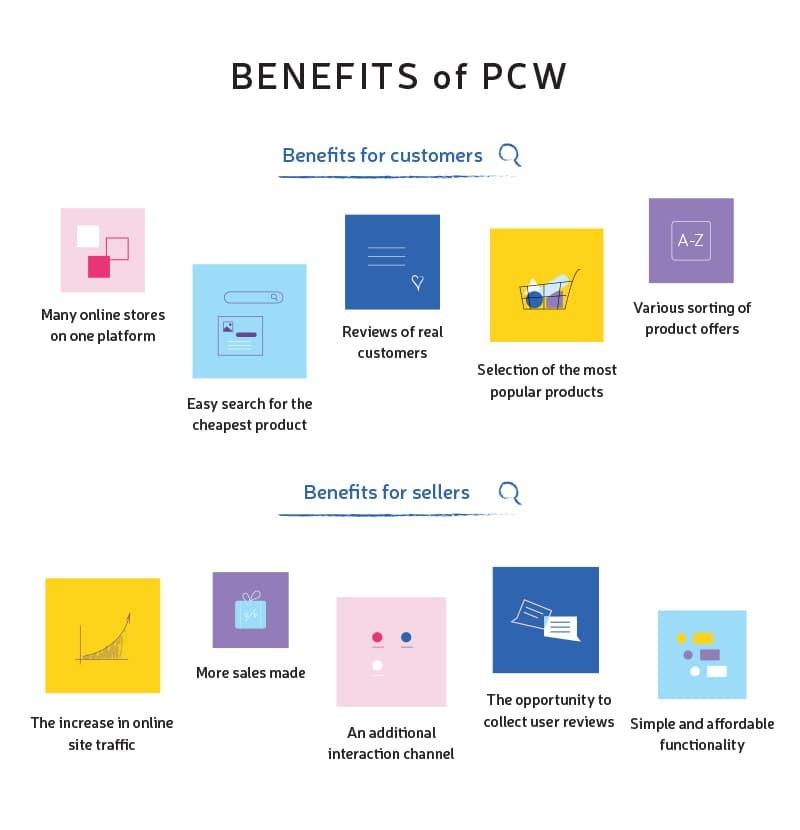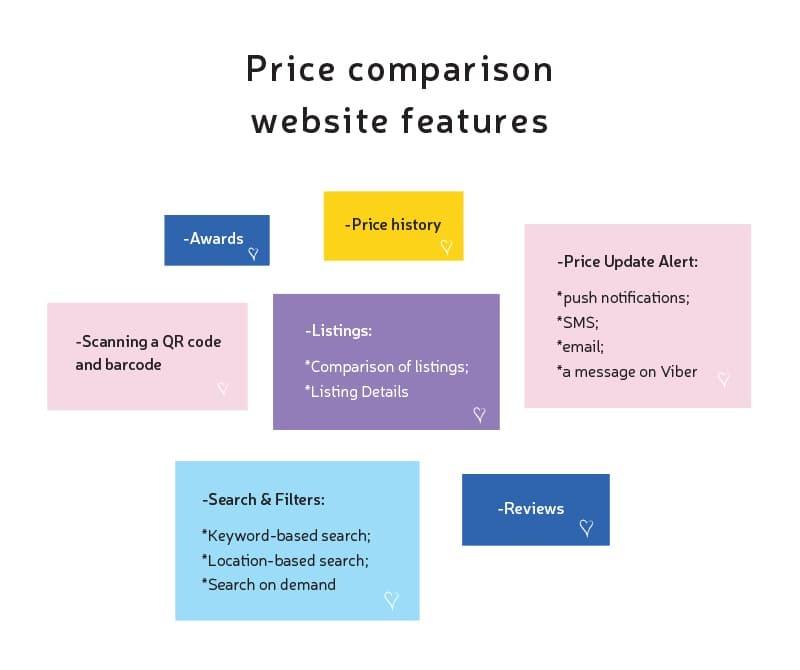Statista investigation assures us that 59% of American users utilize Google Shopping as their price comparison website. Such web-based aggregators are useful to all participants in the process of buying a product or ordering a service. Although price comparison platforms ensure searching for the optimal prices, making them attractive to the consumers, while sellers can consider them as increasing market competition.
But what about the PWC owners? Any venture to establish a price comparison website must reach out to a competent web development company. In our article, we discuss how to start a price comparison website by focusing on the data gathering, development process, monetization options, and much more to show how owners can benefit from this platform.
What Is a Price Comparison Website (PCW)?
What is a service or grocery comparison site? The answer may seem obvious, but we'd like to outline it anyway in order to make sure we're on the same page.
In fact, such a web resource is intended to provide the user with key product information: its price (of course!), a brief description, availability in stores, ratings, reviews, and more. Therefore, in addition to comparing prices, the consumer can also compare other important characteristics of the desired product/service.
However, these aggregators don't actually sell goods. They only collect data and product prices on different websites. To make a purchase, one needs to visit the online store itself (usually there is a link to the web resource in question).
Benefits of PCW
And now it would be useful to figure out the main benefits of price comparison websites.
Seller-Focused Benefits:
First of all, price comparison sites for online shopping give companies an opportunity to expand their sales channels. Furthermore, vendors get a chance to use aggregator’s data to set competitive prices, as well as receive additional traffic of the target audience.
So, the main benefits include:
-
The rapid increase in online site traffic.
-
More sales made.
-
An additional channel of interaction with the audience.
-
The opportunity to collect user reviews and work on the development of the resource.
-
Simple and affordable functionality that allows working with a comparison-shopping website without third-party helpers.
Customer-Focused Benefits:
A good price comparison website is especially necessary for those who constantly make online purchases and don't want to spend too much time trying to find “where is cheaper”. Thus, the benefits include:
-
The possibility to see a huge number of online stores on a single platform.
-
A quick answer to the question of where the cheapest product is.
-
A lot of reviews of real customers.
-
Selection of the most popular goods (they’re usually placed at the top of the lists).
-
Various sorting of product offers.

Where to Get Data to Implement the Comparison Feature?
Before moving on, let's consider a few technical solutions for a website that compares price development and explore their pros and cons. Then, you'll be able to choose the option that best suits your specific project.
Web Scraping
This is a very popular way to get comparison data, although not always legally approved. It’s about web crawlers or spiders periodically visiting pre-selected sites to collect the necessary information.
It acts as if it scrapes data from the web platform (hence the name - web scraping).
The method is rather simple: a specially trained algorithm, which is also an automated code, goes to the main page of an online resource and begins to visit each internal link, parse an HTML document, search for data, and convert it to the specified format.
APIs
Among the digital comparison tools, API integration is being widely used. The method involves obtaining information directly from the vendors themselves via the API. The received data is automatically entered into your database.
The model is especially good if most pricing sites use the API and are willing to share it with you. And we're pretty sure they'll be happy to give you access to their data: in the end, it's beneficial to them too (we've described the benefits above, remember?).
Manually Adding Data
This isn’t the most convenient way to build a price comparison website, of course. Though, we're going to describe it anyway.
So, if sellers don't have an API but want to participate in your program, they can provide you with their information in the form of XML and CSV files. Or you may let them enter data manually.
Such a model is suitable as an addition to the above-described API option.
On-Demand Data
The approach is being used when it comes to specific goods and services (insurance, loans, digital products) or when expert assistance is required (if indicating the price itself isn't enough).
Imagine the situation: the customer chooses a credit card and, of course, wants to know the advantages and disadvantages of each option, say, whether there are any unacceptable conditions or strings attached. So he needs an expert opinion. Your product price comparison website sends a message to the vendor about the request received, and the vendor may satisfy it (if he wants to).
Now you know where to get data to create the analyzed platform. But how to make a price comparison website? What actions, steps or stages does the development require?
We’d like to answer this question below.
How to Create a Price Comparison Website: 5 Essential Steps
Now we’d like to briefly discuss the best step-by-step way of how to make a comparison website by describing the key points of this process.
1. Niche Selection
Prior to launching a PCW, you have to select the correct niche. The key elements to consider are market competition, UVP (unique value proposition), and the target customer.
The first element implies the in-depth analysis of the leading product distributors, like the online marketplaces and specialized websites.
Having a clearly defined unique value proposition is a must to win the client’s attention as it aims to show how your website is going to solve their problem, signifying your competitive advantages.
Regardless of the website’s tech effectiveness and effective inclusion of multiple vendors, you have to know your customers: their portrait, demographics, and customer behavior patterns to ensure the attraction of the service you’re going to provide.
2. Attracting the Partners
It all depends on what technical solutions (from the ones we described earlier) your website is based on. Among the additional elements of how to build a price comparison website we can indicate content marketing and social media marketing.
One of the most essential elements of the first marketing is review integration. The clients trust the buyers’ feedback, so this attraction tactic will generate organic traffic.
Social media marketing can attract the consumers if you engage with the audience, announce some new website features, announce competitions, and discuss the potential discounts.
3. Project Monetization
The possible monetization options for your price comparison platform can represent affiliate commissions, subscription fees, etc.
Regardless of paying per click monetization where the referral links are the source of income, you can monetize the agreed-upon customer actions like downloads or registrations that will enhance your aggregate revenue.
Subscription fees model of monetization is not that common for the PCW, but if you aim to provide your users with personalized recommendations and exclusive offers, then, why not?
4. Make a List of Features
Think over what you want to offer users, what opportunities to please them with. These elements may represent filters, description of products, alerts on price reduction, wish lists, which will benefit your platform diversification and boost monetization.
5. Hire a Reliable Development Partner
Hiring a reliable partner is key to crafting a platform, as the development team can answer the question of how to set up a price comparison website from a technical standpoint by performing the following development stages:
-
Drawing up a basic plan.
-
Prototyping.
-
Design.
-
Web development.
-
Testing.
-
Publication of the project.
-
Support (if required).
Examples of Price Comparison Sites
Thinking about price comparisons, we recall smartphones, household appliances, and other expensive purchases when the cost factor is a key one. But, in reality, there are more options.
Ideally, you need to focus on goods and services with high demand and a small number of competitors. Alas, only new areas, such as AI-based products, the Internet of Things, 3D printing, blockchain technology, and the like, can meet these criteria.
Do you know such a market? You're welcome to build a website to compare prices, you've found your niche. If the answer is no, you’ll have to put up with the presence of competition. There is nothing you can do about it.
If you are interested in the cost to build an e-commerce website, its development process, and its timeline, then the linked article is for you.
Here are some examples of the best price comparison sites top PCW projects you may look at (and even follow their lead):
-
Travel resources, like CruiseCritic (sea cruises).
-
Alcohol products (WineSearcher).
-
Cyclist insurance (say, Bikmo).
-
Clothing price comparison websites, such as Fashiola.
-
Digital services (how about Cable.co.uk?).
-
Books for sale (this resource claims to be the best book price comparison site).
-
Supermarket comparison sites (among them is MySupermarket).
-
Web platforms aimed at gamers (CheapShark).
-
The search for hotels and hostels (such as Trivago).
-
Makeup price comparison sites (take a look at the following example).
Key Features of Price Comparison Website
How to set up a comparison website, and what features does it need? Take a look at the following options:
1. Search & Filters
Any purchase begins with a product search, right? And you have several ways to implement such a feature:
-
Keyword-based search. And be sure to provide various filters and the ability to sort search engine results (by rating, popularity, price, etc.). Among the examples is the famous Google Shopping.
-
Location-based search. The site displays goods/services on a map within a certain territory. Interested in examples of this kind of search? Pay attention to GasBuddy, a site helping users find the best gas prices (here the location issue is important, isn't it?).
-
Search on demand. The option isn't the most convenient, but Kitchify, Parcel2go, and Compare IP take advantage of it. The user fills out a special form, the comparison shopping website sends a request to vendors, and it’s up to them to satisfy the request made.
2. Listings
Two components are important here:
-
Comparison of listings. That is, the user wants to find a certain product (let it be a new smartphone). They enter the name and get a list of options with the specified prices. Now they are free to choose what seems optimal and go to the listing details.
-
Listing Details. Before moving to the sales site, the user would be glad to get acquainted with the main characteristics of the smartphone they are going to buy (in the end, the purchase is quite expensive).
3. Price Update Alert
-
If the customer isn't satisfied with the proposed price range, they may agree to receive notifications of price updates. So they'll be able to track the price of the goods to make the desired purchase when it reaches the mark they need. A feature can be implemented in the following ways:
-
push notifications;
-
SMS (if the user is ready to indicate his phone number);
-
email;
-
a message on Viber (or another popular messenger).
4. Reviews
At least 90% of buyers trust reviews (almost the same way they trust the advice of friends), and, therefore, they readily read them before making the final choice. So such a feature will be in high demand.
5. Price History
The feature is optional; you’ll manage to build a price comparison website and make it successful without it either. However many users will appreciate the chance to track price trends in a given time interval.
6. Awards
You‘ll hardly be surprised that users love all sorts of rewards and bonuses. There are many options: cashback, gift cards, discount coupons, participation in the competition, etc.
7. Scanning a QR Code and Barcode
This aspect allows customers to compare prices in local stores using the smartphone’s camera.

How Can Price Comparison Websites Get Monetization?
The cost to build a website to compare prices cannot be very low; it means you need to find a way to recoup your expenses - and revenue from it, of course. So if you want the project to pay off and start bringing you money, you should actively monetize it.
Let's consider the best of the possible options:
1. Cost Per Click (CPC) or Pay Per Click (PPC)
CPC or PPC are the most common way to monetize price comparison sites. When people go from your resource to the seller’s website, they use referral links. It is on such links that you can earn (you're being paid per transition, that is, per click) if you connect to a special affiliate program (which is quite easy to do).
2. Commission from the Order Placed
Commission from the order placed is another popular monetization model. The essence is completely clear: the buyer finds the site of interest using your price comparison website, makes an order, and the vendor he has chosen must pay you a certain commission (so it's not Pay Per Click but Pay Per Order).
3. Paid Placement
It is about collecting fees from sellers who must pay you a fixed amount of money if they want to be placed on your site.
4. Google Ads
This type of monetization is used by almost all PWC platforms. The level of earnings depends on the popularity of the site (the number of clicks), and the advertisement itself automatically adjusts to the content of a particular page.
5. Brand Advertising
Here, we’re dealing with the placement of advertising offers of certain brands at the top of your listings (pay-per-click or impression). Of course, your resource should be quite demanded (heavy hitter, they call it), otherwise, the brand owner is unlikely to be interested in such cooperation.
6. Target Marketing
Shopping comparison sites can analyze the behavior of their users in order to understand their consumer needs. And this data would come in really handy to start targeted marketing.
Summary
In our article, we aimed to clarify how to start a price comparison website by defining the concept and analyzing the elements of where to get the required data. Although PCW development is a complex project that requires a clear definition of the goals of your project, you may keep in mind that diversifying your platforms with unique customer-oriented features might give you an opportunity to enhance your revenue, focusing on the analyzed monetization models. Hence, choosing a reliable partner will make your dream PCW come true. Let’s do it together.



